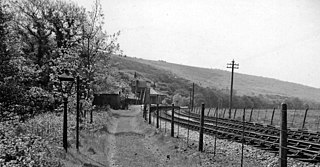
The River Ogmore is a river in South Wales that is popular with anglers. It runs generally from north to south from the Ogmore Vale and Gilfach Goch, past Bridgend and Ogmore. The River Ogmore rises at Craig Ogwr in the Ogmore Valley as the Ogwr Fawr before it links with the Ogwr Fach at Blackmill. The River Llynfi, the River Garw and finally the River Ewenny in its estuary are all tributaries of the Ogmore which flows into the sea between Ogmore-by-Sea and the Merthyr Mawr sand-dunes.

Ogmore-by-Sea is a seaside village in St Brides Major community in the Vale of Glamorgan, Wales. It lies on the western limit of the Glamorgan Heritage Coast of south Wales. The population in 2011 was 878.

Rogerstone is a large village, ward and community (parish) in the suburb of the city of Newport, southeastern Wales. The area is governed by the Newport City Council. The village falls within the ancient parish of Bassaleg and historic county of Monmouthshire.
The Garw Valley Railway is the trading name of the Bridgend Valleys Railway Company Limited. It operates a short section of 4 ft 8 1⁄2 instandard gauge railway located in South Wales, which is being recreated as a heritage railway. Formerly part of the Llynvi and Ogmore Railway (L&OR) and built by the Great Western Railway (GWR), the line was used for freight and passenger services, with most of the track still in place between Brynmenyn and Pontycymer. The project currently has a train shed at Pontycymer, and hopes to initially offer brake van rides between Pontycymer and Pant-y-Gog, a distance of 0.5 miles (0.8 km).

Merthyr Vale railway station is a railway station serving the villages of Merthyr Vale and Aberfan in Merthyr Tydfil, Wales. It is located on the Merthyr branch of the Merthyr Line. Passenger services are provided by Transport for Wales.

Treherbert is a village and community situated at the head of the Rhondda Fawr valley in the county borough of Rhondda Cynon Taf, Wales. Historically part of Glamorgan, Treherbert is a former industrial coal mining village which was at its economic peak between 1850 and 1920. Treherbert is the upper most community of the Rhondda Fawr and encompasses the districts of Blaencwm, Blaenrhondda, Tynewydd and Pen-yr-englyn.
In 1861 the Llynvi Valley Railway was opened in Glamorganshire, Wales, to convey mineral products to the Bristol Channel at Porthcawl. It adopted an earlier tramroad, the Duffryn Llynvi and Porthcawl Railway. The Llynvi and Ogmore Railway was opened in 1865, and the two companies amalgamated to form the Llynvi and Ogmore Railway in 1866. At first Porthcawl harbour was an important destination for onward transport, but this soon declined.

Ogmore Vale is a village in the county borough of Bridgend, Wales on the River Ogmore. The village's main source of income came from coal mining. Up until the year 1865, the Ogmore valley was a quiet, isolated, rural hill farming community of less than ten farms and a few cottages. Today, along with Nantymoel and Price Town it makes up the community of Ogmore Valley.

The Ewenny River is a river in South Wales. For most of its 10 miles (16 km) length, it forms the border between the Vale of Glamorgan and Bridgend. It is a major tributary of the River Ogmore, which it joins near its estuary.
The Llantrisant and Taff Vale Junction Railway was a railway company that constructed a standard gauge line in South Wales, connecting Llantrisant and the Taff Vale Railway near Treforest. It ran through thinly populated country, and linked to a number of iron mines, collieries and other mineral sites. It opened in stages in 1863 and 1864. In 1865 through passenger trains from the Cowbridge Railway ran over the line, to Pontypridd, although for some time there were no passenger stations on its own network. At the Llantrisant end, it was reliant on broad gauge railway companies which were not always friendly to it. The company leased its line to the Taff Vale Railway in 1870.

Tynewydd is a village located in the County Borough of Rhondda Cynon Taf, south Wales. With Treherbert, Blaencwm, Blaenrhondda and Pen-yr-englyn it is part of a community of Treherbert. The village lies in the former industrial coal mining area at the head of Rhondda Fawr, the larger of the Rhondda Valleys.

The Ely Valley Railway (EVR) was a broad gauge railway company in South Wales, which opened a mineral line between Llantrisant station on the South Wales Railway main line and pits at Mwyndy and Penrhiwfer in 1860.
Maesteg railway station served the town of Maesteg, Glamorgan, Wales from 1898 to 1964 on the Llynvi and Ogmore Railway.

Maesteg Castle Street railway station served the town of Maesteg, Glamorgan, Wales from 1864 to 1970 on the Llynvi and Ogmore Railway.

Birch Vale railway station served the village of Birch Vale, Derbyshire, England, from 1868 to 1970 on the Hayfield branch.

Blackmill railway station served the village of Blackmill, in the historical county of Glamorgan County Council, Wales, from 1873 to 1961 on the Ogmore Valley line.

Wyndham Halt railway station served the village of Wyndham, in the historical county of Glamorgan, Wales, from 1942 to 1958 on the Ogmore Valley Railway.
Nantymoel railway station served the village of Nant-y-moel, in the historical county of Glamorgan, Wales, from 1873 to 1958 on the Ogmore Valley Railway.

Brynmenyn railway station served the village of Brynmenyn, in the historic county of Glamorgan, Wales, from 1873 to 1958 on the Garw Valley Railway.
Kenfig Hill railway station served the village of Kenfig Hill, in the historical county of Glamorgan, Wales, from 1865 to 1958 on the Llynvi and Ogmore Railway.













